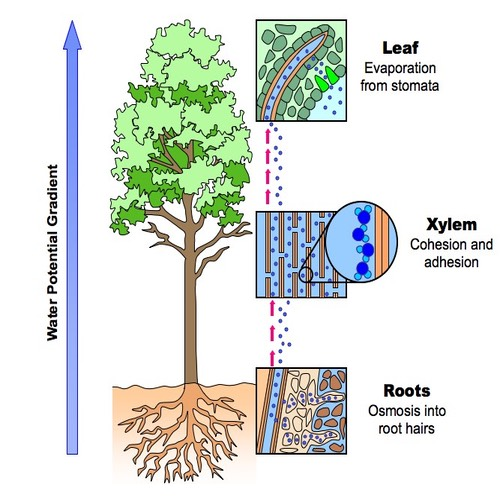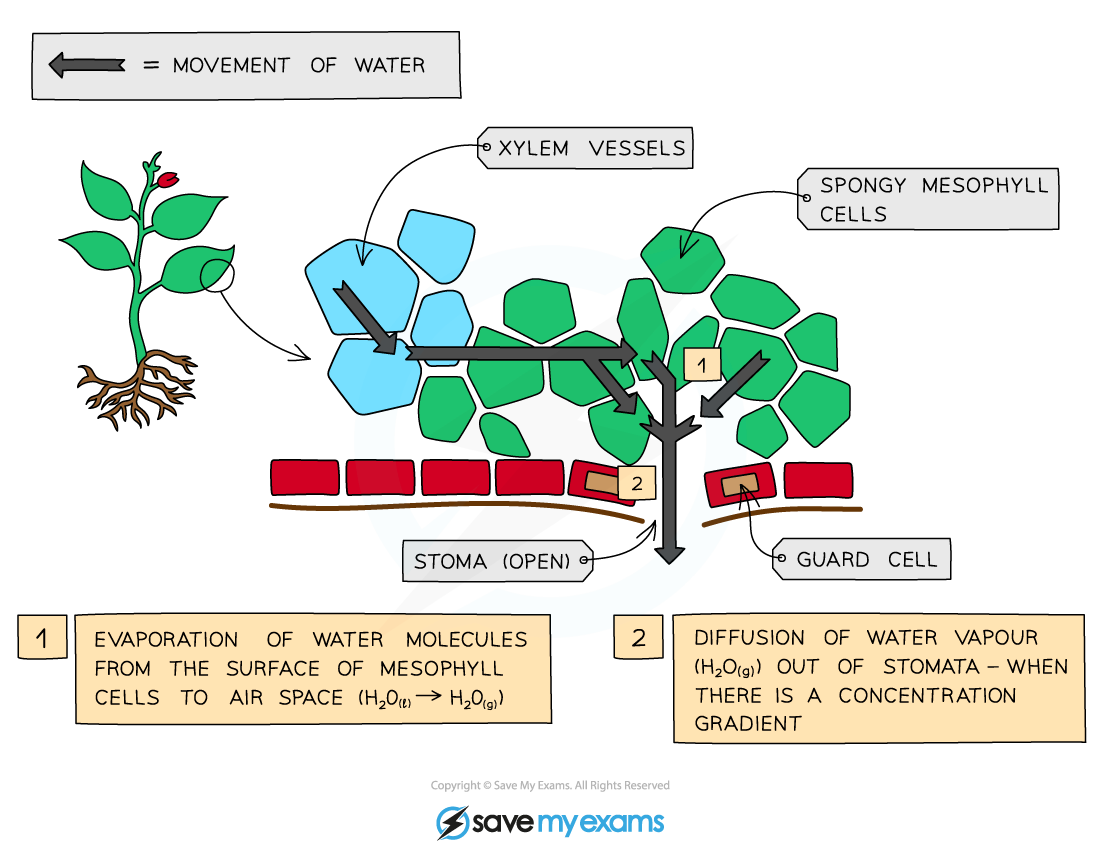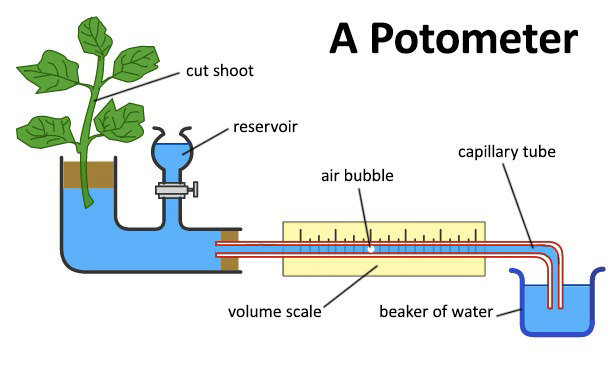3.3.4.2 - Mass Transport in Plants
1/92
There's no tags or description
Looks like no tags are added yet.
Name | Mastery | Learn | Test | Matching | Spaced |
|---|
No study sessions yet.
93 Terms
Give 2 tissues for transport in plants
xylem
phloem
What does the xylem transport?
water, and mineral ions
What does the phloem transport?
assimilates
Describe the structure of the xylem?
xylem vessels
dead cells
no end walls
no nuclei
walls lignified
lignin arranged in spirals or broken rings
bordered pits
Why does the xylem have no end walls with no nuclei or cytoplasm?
to allow for a continuous column of water
What are the xylem walls thickened with?
lignin
WHat is the function of the lignified xylem walls?
prevents the tubes from collapsing and waterproofs the walls. also provides strength amd flexibility
Describe the pattern of the lignin in xylem walls?
spiral or network of broken rings
What does annular lignin mean?
spiral
What does reticulate lignin mean?
broken rings
What is the advantage of bordered pits in xylem?
water can pass between adjacent bessels or part of a plant
What theory explains the movement of water up a plant?
tension-cohesion
Describe the cohesion-tension theory?
water evaporates from the leaf surface in transpiration
water moves into cells in the leaf down a WPG in osmosis
causing low HS pressure near the leaf
at the roots, mineral ions are actively transported into the xylem, lowering WP so osmosis moves water in
high HS pressure at root
causes tension in the xylem
because water molecules are cogesive there is a column of water pulled upwards
In what process does water leave a leaf?
transpiration
What does transpiration cause in the xylem?
tension
Why does transpiration cause tension in the xylem?
water moves out of xylem down a water potential gradient
Why is there low HS pressure at the xylem at leaves?
water moves out by osmois
Why is there high hydrostatic pressure at the roots in xylem?
water moves in by osmois
Why are water molecules cohesive?
hydrogen bonding between them
Due to tension and cohesion what is formed in the xylem?
a continuous column of water
When water is pulled upwards in the xylem, what happens at the root?
the water is taken up and replaced
Draw a diagram of the cohesion-tension theory?

Define transpiration
the loss of water vapour from the aerial parts of the plant such as through the stomata
Where does transpiration mainly occur?
the leaves
Give 3 processes involved in water movement through the leaf
osmosis from the xylem to the mesophyll cells
evaporationf rom the surface of mesophyll cells into intercellular spaces
diffusion of water vapour from the intercellular spaces out through stomata
Why is water replaced as it is lost?
due to the continuous stream
Draw a diagram of transpiration?

In what state is water lost in transpiration?
water vapour
What is transpirtaion important for?
water is required in the leaves for photosynthesis
water is required to enable cells to grow
keeps cells turgid
ensures usefull mineral ions are pulled up the plant
evaporation of wayer keeps plant cool
Give 8 factors that affect transpiration?
number of leaves
number, size and position of stomata
waxy cuticle
light intensity
temperature
humidity
wind movement
water availability
As number of leaves increases, what happens to rate of water loss and why?
it increases as there is greater surface area for diffusion
As number of stoma (and size) increase, what happens to rate of water loss and why?
increases as surface area for diffusion of water vapour increass
If stoma are placed on the lower epidermis and not the upper, what jappens to water vapour loss and why?
less water vapour loss as more shaded
As waxy cuticle gets thicker, what happens to rate of water loss and why?
rate of water loss decreases as it prevents evaporation
As temperature increases, what happens to rate of water loss and why?
increases as the kinetic energy of the water molecules is greater
As humidity increases, what happens to rate of water loss and why?
decreases as there is a smaller water potential gradient
As wind movement increases, what happens to rate of water loss and why?
increases as water vapour is removed so greater water potential gradient
As water availability decreases, what happens to rate of water loss and why?
decreases as the stomata close
Draw a graph for rate of transpiration and humidity
Draw a graph for rate of transpiration and temperature
What is xerophyte?
plants which can survive in dry places such as deserts and sand dunes
Give 8 examples of adaptations of xerophytes?
smaller leaves
thick waxy cuticle
stomata close when very hot
hairs on leaf surface
stomata sunk in pits
rolling of leaves
loss of leaves
high salt in cells
Why does having smaller leaves reduce water loss?
smaller surface area
Why does having a thicker waxy cuticle reduce water loss?
reduces evaporation
Why does the stomata closing when very hot reduce water loss?
reduces water loss when water availability is low
Why does having hairs on leaf surface reduce water loss?
traps an layer of water vapour- smaller water potential gradient
Why does having sunk stomata reduce water loss?
traps an layer of water vapour- smaller water potential gradient
Why does having rolling leaves reduce water loss?
traps an layer of water vapour- smaller water potential gradient
Why does having less/no leaves reduce water loss?
no/less SA for water loss
Why does having high salt concentration reduce water loss?
decsreases WP in cells so smaller WPG
Draw a diagram of a potometer

What equipment is involved in a potometer?
lead shoot
water reservoir
screw clip
scale
What does a potometer measure?
water uptake
Why isnt a potometer an accurate measure of transpiration rate?
water is used for other things, e.g cell turgidity
Give the steps to set up a potometer
cut the healthy shoot underwater
cut shoot at a slant
check aparatus is full of wayer
insert shoot into aparatus
remove potometer from water
ensure airtight joints
dry leaves
keep conditions constant
allow shoot to acclimatise
screw clip
keep ruler fixed
measure
Why do you cut the shoot underwater?
to prevent air entering xylem
Why do you cut the shoot at a slant?
increase surface area
Why do you ensure all joints are airtight in a potometer?
to precent air lock
What conditions need to be kept constant when using a potometer?
temperature
humidity
light
wind
How do you calculate the rate of transpiration?
(pi*r² *d/time)
What do phloem tissue consist of?
sieve tubes elements
companion cells
Draw a diagram of phloem

Describe the composition of sieve plate cells
little cytoplasm, few organelles and no nucleus
no lignified walls
cross-walls at intervals called sieve plates
sieve plates connect elements
sieve plates allow assimilates to flow
plasmodesmata link the cytoplasm of companion cells and sieve tube elements
What exists between sieve tubes?
sieve plates
What are the purpose of sieve plates?
they allow assimilates to flow easily
What are the names for the gaps in the cell membrane and wall between sieve tubes and companion cells?
plasmodesmata
What are plasmodesmata?
gaps/ pores that connect the cytoplasm of the companion cells and the sieve tube elements
Describe the cytoplasm of sieve tubes
there is little of it
Describe the cytoplasm of companion cells?
dense
How are companion cells adapted?
they have a large nucleus, many mitchondria, many proteins in the plasma membrane and many ribosomes
Why do companion cells require many mitochondria?
produce ATP for active transport
Define translocation?
the movement of assimilates from source to sin. It is an energy-requiring process and happens in the phloem
Give 4 examples of assimilates
amino acids
sucrose
solutes
Does translocation require ATP?
yes
Define source
the part of the plant that releases the assimilates (leaf)
Define sink
the part of the plant that recieves the assimilates
What is the best theory for translocation called
mass flow hypothesis
What is the first step of mass flow hypothesis
active loading
what is the purpose of active loading
to load the sucrose into the phloem
what are the steps of active loading
the companion cells use ATP to actively transport hydrogen ions out of their cytoplasm and into surrounding tissue
this sets up a concentration gradient so hydrogen ions diffuse back into the companion cells via co-transport with sucrose via co transporter proteins
This sets up a concentration gradient so sucrose diffuses from the companion cells into the sieve tube elements via plasmodesmata
What type of diffusion is that via the plasmodesmata
NOT FACILITATED - no proteins
What are the steps of mass flow hypothesis?
sucrose is actively loaded into the sieve tube element
this reduces the water potential at the sieve tube
this causes water to move into the sieve tube element by osmosis from the surrounding tissue
this increases hydrostatic pressure at the sieve tube element
at the sink, the solutes ate used, leaving the sieve plate via active transport or diffusion
this decreases the water potential in the sieve tube so water moves out by osmosis, reducing the hydrostatic pressur
water, and its dissolved assimilates, moves from source to skin down a hydrostatic pressure gradient
What might assimilates be used for at the sink?
converted into starch
respiration
Give 4 pieces of evidence that supports mass flow hypothesis
use of aphids
ringing a tree
radioactive traces
metabolic inhibitors
What are aphids
insects that feed on a plant stem
How does the use of aphids provide evidence for mass flow?
the aphid sylet is in the phloem
the sap flows our quicker closer to the leaves (the source), showing greater hydrostatic pressure
ecidence there is a hydrostatic pressure gradient
What is ringing a tree?
removing a ring of bark that includes the phloem but not xylem
How does ringing a tree provide evidence for mass flow hypothesis
a bulge forms above the ringed area providing evidence that there is a downward flow of sugars
why does a bulge form above the ringed area
the sugars can’t pass the ringed area, increasing water potential
How are radiactive tracers used to provide evidence for mass flow hypothesis?
they can be used to track the organic substances
Which radioactive tracker is used
carbon dioxide containing radioactive isotope C14, this is incorporated into organic substances , eg sucrose, which is moved around via translocation
How do metabolic inhibitors provide evidence fot msss flow hypothesis?
translocation is stoped when a metabolic inhibitor is used (prevents formation of ATP), as it stops it proves that active transport is involved
Give 2 pieces of evidence against mass flow?
sugar travels to many different sinks not just the one with lowest hydrostatic pressure
sieve plates would create a barrier to mass flow